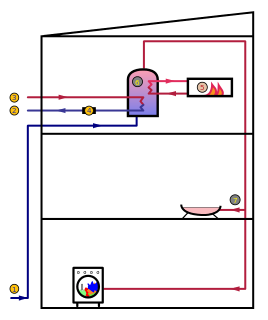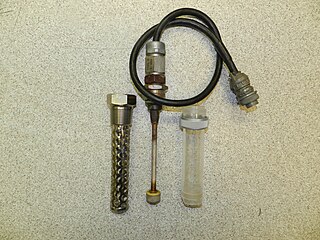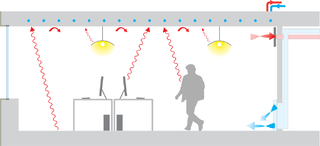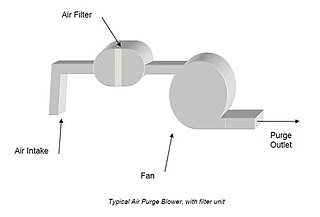
Solar thermal energy (STE) is a form of energy and a technology for harnessing solar energy to generate thermal energy or electrical energy for use in industry, and in the residential and commercial sectors.

Water heating is a heat transfer process that uses an energy source to heat water above its initial temperature. Typical domestic uses of hot water include cooking, cleaning, bathing, and space heating. In industry, hot water and water heated to steam have many uses.

Solar water heating (SWH) is the conversion of sunlight into heat for water heating using a solar thermal collector. A variety of configurations are available at varying cost to provide solutions in different climates and latitudes. SWHs are widely used for residential and some industrial applications.

A solar thermal collector collects heat by absorbing sunlight. The term "solar collector" commonly refers to solar hot water panels, but may refer to installations such as solar parabolic troughs and solar towers; or basic installations such as solar air heaters. Concentrated solar power plants usually use the more complex collectors to generate electricity by heating a fluid to drive a turbine connected to an electrical generator. Simple collectors are typically used in residential and commercial buildings for space heating. The first solar thermal collector designed for building roofs was patented by William H. Goettl and called the "Solar heat collector and radiator for building roof".

The Easy-Bake Oven is a working toy oven which Kenner introduced in 1963, and which Hasbro still manufactured as of late April 2016. The original toy used an ordinary incandescent light bulb as a heat source; current versions use a true heating element. Kenner sold 500,000 Easy-Bake Ovens in the first year of production. By 1997, more than 16 million Easy-Bake Ovens had been sold.
A space sunshade or sunshield is a parasol that diverts or otherwise reduces some of a star's radiation, preventing them from hitting a spacecraft or planet and thereby reducing its insolation, which results in reduced heating. Light can be diverted by different methods. First proposed in 1989, the original space sunshade concept involves putting a large occulting disc, or technology of equivalent purpose at the L1 gravitation point between the Earth and Sun.

Electric heating is a process in which electrical energy is converted to heat energy. Common applications include space heating, cooking, water heating and industrial processes. An electric heater is an electrical device that converts an electric current into heat. The heating element inside every electric heater is an electrical resistor, and works on the principle of Joule heating: an electric current passing through a resistor will convert that electrical energy into heat energy. Most modern electric heating devices use nichrome wire as the active element; the heating element, depicted on the right, uses nichrome wire supported by ceramic insulators. A warning that these can go to very high temperatures and create excruciating burns

Dewcells, dewcels or dew cell are instruments used for determining the dew point. They consist of a small heating element surrounded by a solution of lithium chloride. As the LiCl absorbs moisture from the air, conduction across the heating element increases, current in it increases, and heat increases, evaporating moisture from the salt solution. At a certain temperature the amount of moisture absorbed by the salt solution equals the amount evaporated (equilibrium).

An electric blanket is a blanket containing integrated electrical heating wires. There are several types; underblankets, overblankets, throws and duvets. An electric underblanket is placed above the mattress and below the bottom bed sheet. This is the most common type in the UK and Commonwealth countries, where it is known by default as an "electric blanket"; in the U.S. and Canada, where it is less common, it is called an electric heated mattress pad. An electric overblanket is placed above the top bed sheet, and is the most common type in the U.S. and Canada, where it is called an "electric blanket".

A space heater is a device used to heat a single, small area. In contrast, central heating is used to heat many connected areas, such as all the rooms in a house. Space heaters are powered either by electricity or by a burnable fuel like natural gas, propane, fuel oil, or wood pellets. Portable space heaters are usually electric because a permanent exhaust is needed for heaters that burn fuel.

A convection heater is a heater which operates by air convection currents circulating through the body of the appliance, and across its heating element. This heats up the air, causing it to increase in volume and so become buoyant and rise. Oil heaters are an example of this kind of heating appliance. A convection heater may have an electrical heater element, a hot water coil, or a steam coil. Because of the natural ventilation, they are quieter in operation than fan heaters.

A solar combisystem provides both solar space heating and cooling as well as hot water from a common array of solar thermal collectors, usually backed up by an auxiliary non-solar heat source.

A food dehydrator is a device that removes moisture from food to aid in its preservation. Food drying is a method of preserving fruit, vegetables, and animal proteins that has been practiced since antiquity.

An air well or aerial well is a structure or device that collects water by promoting the condensation of moisture from air. Designs for air wells are many and varied, but the simplest designs are completely passive, require no external energy source and have few, if any, moving parts.

Solar air heating is a solar thermal technology in which the energy from the sun, insolation, is captured by an absorbing medium and used to heat air. Solar air heating is a renewable energy heating technology used to heat or condition air for buildings or process heat applications. It is typically the most cost-effective out of all the solar technologies, especially in commercial and industrial applications, and it addresses the largest usage of building energy in heating climates, which is space heating and industrial process heating.

Radiant cooling is the use of cooled surfaces to remove sensible heat by radiation and convection. It is related to radiant heating. Radiant systems that use water to cool the radiant surfaces are called hydronic systems. Unlike “all-air” air conditioning systems that circulate cooled air only, hydronic radiant systems circulate cooled water in pipes through specially-mounted panels on a building’s floor or ceiling to provide comfortable temperatures. There is a separate system to provide air for ventilation, dehumidification, and potentially additionally cooling. Radiant systems are less common than all-air systems for cooling, but can have advantages compared to all-air systems in some applications.

The Solar Building, located in Albuquerque, New Mexico, was the world's first commercial building to be heated primarily by solar energy. It was built in 1956 to house the engineering firm of Bridgers & Paxton, who were responsible for the heating system design. The novel building received widespread attention, with articles in national publications like Life and Popular Mechanics, and was the subject of a National Science Foundation-funded research project in the 1970s. It was added to the New Mexico State Register of Cultural Properties in 1985 and the National Register of Historic Places in 1989, only 33 years after it was built.

An air purge system is used to flush electrical control equipment with clean air before it is turned on. This ensures that the functionality of the equipment is not affected or damaged by the contaminants from the surrounding environment.

A storage water heater, or a hot water system (HWS), is a domestic water heating appliance that uses a hot water storage tank to maximize heating capacity and provide instantaneous delivery of hot water. Conventional storage water heaters use a variety of fuels, including natural gas, propane, fuel oil, and electricity. Less conventional water heating technologies, such as heat pump water heaters and solar water heaters, can also be categorized as storage water heaters.
The Solar Heat Collector & Radiator is a heat collecting and heat radiating roof structure, designed for building roofs specifically. It was built to be used in conjunction with solar energy and uses a system of air circulation for increased efficiency. A solar heat collector, or solar thermal collector, is used today to capture solar radiation through electromagnetic radiation with the use of solar hot water panels, solar parabolic troughs, or solar towers. Today many people create their own DIY solar heat collectors, but the inventor William Goettl was the first to design and patent this technology.



















